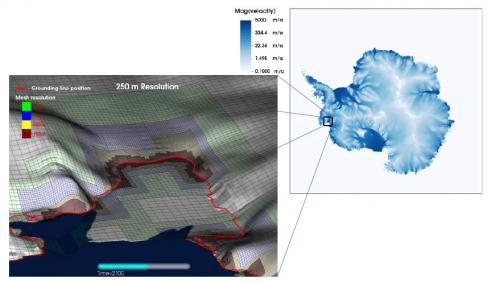Berkeley code captures retreating Antarctic ice

Satellite observations suggest that the shrinking West Antarctic ice sheet is contributing to global sea level rise. But until recently, scientists could not accurately model the physical processes driving retreat of the ice sheet. Now, a new ice sheet model—called Berkeley-ISICLES (BISICLES)—is shedding light on these details.
Developed in a collaboration between computational scientists at Lawrence Berkeley National Laboratory (Berkeley Lab), and climate scientists at the Los Alamos National Laboratory and the University of Bristol, BISICLES allows researchers to model regions of interest—like the retreating edge of an ice-sheet—at sub-kilometer resolution, while employing computationally cheaper coarser resolution in areas that don't need such fine detail. This allows an accurate, high-resolution view of processes like glacier surges, ice streams, and grounding-line migration, at a relatively low computational cost.
This video shows one possible scenario for Antarctica's rapidly changing Amundsen Sea Embayment at two different model resolutions over a period of 218 years (from 1982 to 2200). In all three clips, the grounding line—where ice flowing into the sea separates from the bedrock and begins to float—is shown as a red line, and the speed of the flowing ice is depicted by brown coloring (the darker the brown, the faster the ice is flowing).
"When you watch these simulations side-by-side it is apparent that you need very fine resolution, better than one kilometer, to accurately simulate ice streams and grounding line migration," says Dan Martin, a Berkeley Lab computational scientist who helped develop BISICLES. Martin and his collaborators generated the simulations using the BISICLES code and up to 800 processor cores on the National Energy Research Scientific Computing Center's (NERSC's) Hopper system.
- Clip #1 is a simulation of the evolving Amundsen Sea Embayment using uniform four-kilometer (4 km) resolution everywhere. An incursion of warm water beginning in the present day and growing further after 2100 causes the floating ice shelves to melt from below. Although this simulation does capture the loss of the floating ice shelves, it shows no noticeable movement of the grounding line and minimal effects in the ice upstream.
- Clip #2 is a simulation of the retreating Amundsen Sea Embayment with Adaptive Mesh Refinement (AMR), which Martin incorporated into the BISICLES code. Using this tool, researchers can dynamically resolve regions of interest at extremely high resolutions (250 meters in this case), while maintaining much coarser resolution where appropriate. At this resolution, researchers can see the grounding line retreat significantly even before 2100—something that doesn't show up in the previous (uniform 4km resolution) clip, but which has already been observed from space. After 2100, the glacier re-doubles its retreat. Sufficiently resolving the grounding line and getting the retreat correct has visible effects upstream of the grounding line in terms of a dramatic increase in ice mass loss and the associated visible "deflation" of the ice surface.
- Clip #3 is the same simulation as the Clip #2, but the AMR meshes are identified. Green identifies regions that are modeled at 2km resolution, blue represents 1km, yellow is 500 meters and brown is 250 meters.
Berkeley Lab contributes to BISICLES code
In its Fourth Assessment Report in 2007, the United Nations Intergovernmental Panel on Climate Change (IPCC) deemed contemporary state-of-the-art ice sheet models inadequate for making realistic projections about global sea level rise. In response, the Ice Sheet Initiative for Climate Extremes (ISICLES), funded by the DOE Advanced Scientific Computing Research Program, sought to leverage the expertise of computational scientists to help improve the models.
As a part of this program, computational scientists at Berkeley Lab (Dan Martin, Esmond Ng, Sam Williams, and Woo-Sun Yang) formed a collaboration with climate scientists at the Los Alamos National Laboratory (William Lipscomb) and the University of Bristol (Stephen Cornford and Tony Payne), which led to the development of a code called Berkeley-ISICLES (BISICLES).
Martin developed scalable Adaptive Mesh Refinement (AMR) ice sheet modeling tools, built on the Chombo software framework, and linked them to the existing Community Ice Sheet Model code (CISM). With AMR, researchers can now model dynamic points of interest at extremely high resolution, while maintaining a coarser resolution for areas that don't change as quickly. This enables accurate models at relatively low computational cost. The collaboration was so successful that the DOE continued supporting this work as part of PISCEES (Predicting Ice Sheet and Climate Evolution at Extreme Scales), a multi-institutional SciDAC Applications Partnership, which aims to further improve ice sheet models.
More information: crd.lbl.gov/groups-depts/ANAG/ … limate-applications/
Provided by Lawrence Berkeley National Laboratory


















